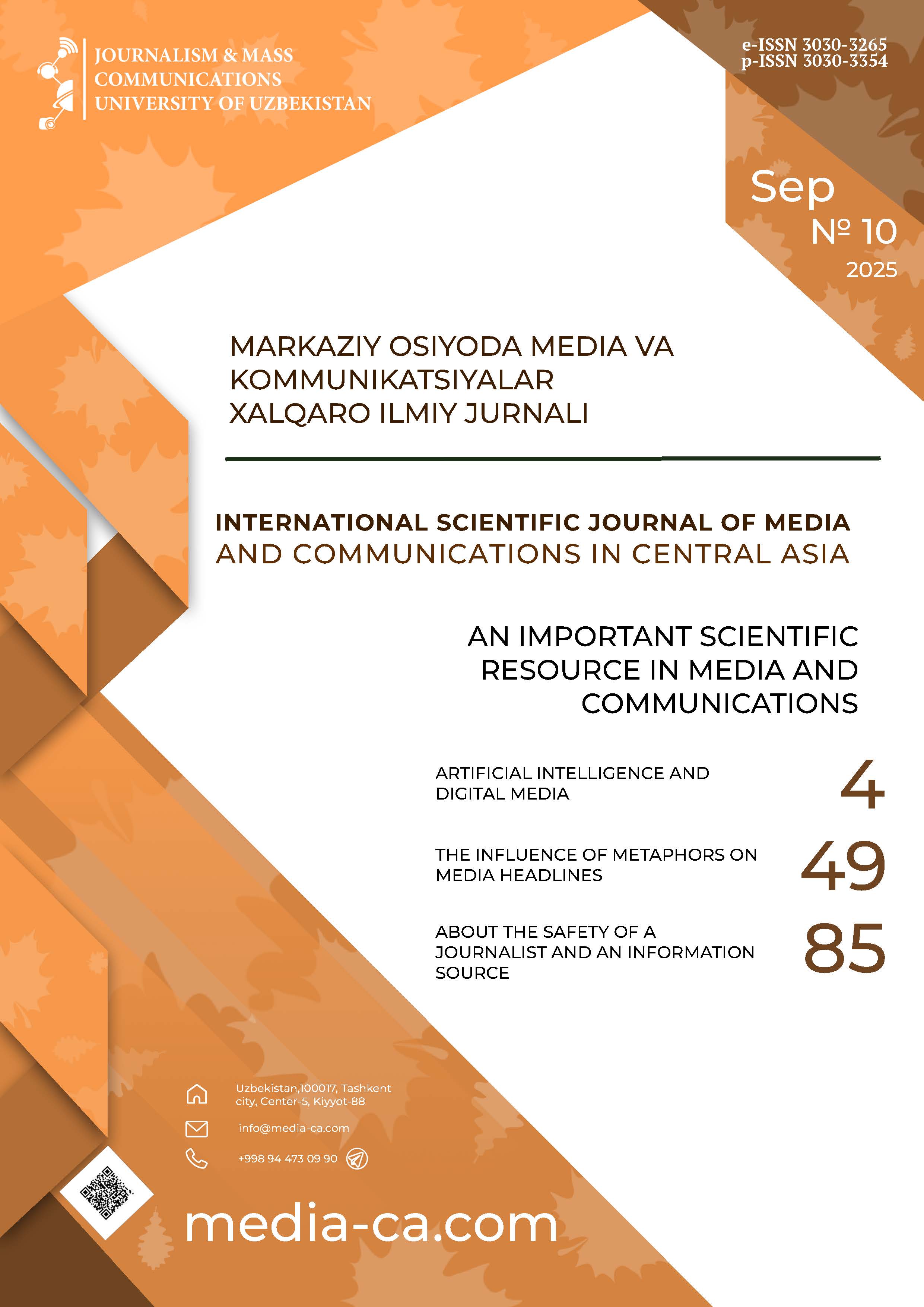DEICTIC FIELD “TIME OF ACTION” IN THE SEMANTICS OF THE PASHTO LANGUAGE, THE “TIME” FIELD: BACKGROUND OF THE PROBLEM
Published 2025-10-04
Keywords
- Semantic field,
- time,
- deixis,
- deictic field,
- Pashto adverbs
- temporal localization,
- speech mode,
- narrative mode ...More
How to Cite
Abstract
The article examines the semantic modeling of the category of time in language through the lens of deictic field theory, with a focus on Pashto adverbs. It outlines four major approaches to modeling semantic fields - phenomenological, lexical-semantic, functional-grammatical, and functional-semantic - highlighting their application to the temporal domain. Special attention is given to the concept of deixis, understood as the reference of linguistic units to participants, time, and space of the speech act, and its role in structuring temporal meaning. Based on an analysis of thirteen non-derivative Pashto temporal adverbs, the study identifies the deictic field “time of action” as a system organized by three oppositions: speech vs. narrative modes, moment of speech vs. moment of another action, and coincidence vs. precedence vs. sequence. The research demonstrates that Pashto temporal adverbs acquire their semantics in the communicative act, functioning as correlates between the moment of speech and narrated events, and are thus integral to expressing temporal relations in discourse.
References
- Арутюнова, Н.Д. (2007). Проблемы морфологии и словообразования (на материале испанского языка). Москва. ЛКИ. URL: https://www.iprbookshop.ru/15128.html (Дата обращения 15.08.2025).
- Грюнберг, А.Л. (1987). Очерк грамматики афганского языка (пашто). Ленинград. Наука. URL: https://rusneb.ru/catalog/000199_000009_001341411 (Дата обращения 15.08.2025).
- Дворянков, Н.А., Еремичева, Т.И., & Лебедев, К.А. (1950). Язык пушту [URL отсутствует]. Москва. Издательство восточной литературы. (Дата обращения 15.08.2025)
- Дворянков, Н.А. (1960). Язык пушту (серия Языки зарубежного Востока и Африки; Ин-т народов Азии, АН СССР, под общ. ред. Г. П. Сердюченко). Москва. Издательство восточной литературы. URL: https://search.rsl.ru/ru/record/01006106229 (Дата обращения 15.08.2025)
- Дмитриева, О.И. (2005). Динамическая модель русской внутриглагольной префиксации (диссертация … доктора филологических наук, 10.02.01). Саратов: [б. и.]. URL: https://rusneb.ru/catalog/000199_000009_002901143 (Дата обращения 15.08.2025)
- Жаналина, Л.К. (2015). Две формы речевой деятельности: соотношение номинации и коммуникации. Вестник Кемеровского государственного университета, (4), 74–79. URL: https://cyberleninka.ru/article/n/dve-formy-rechevoy-deyatelnosti-sootnoshenie-nominatsii-i-kommunikatsii (Дата обращения 15.08.2025)
- Земская, Е.А. (1992). Словообразование как деятельность [E. A. Zemskaya (E. A.)] (220 с.; ISBN 5-02-011082-5). Москва. Наука. URL: https://rusneb.ru/catalog/000199_000009_001643125 (Дата обращения 15.08.2025)
- Калинина, З.М. (1972). Очерки по лексикологии современного литературного пушту (АН СССР. Ин-т востоковедения). Москва. Наука. URL: https://rusneb.ru/catalog/000199_000009_007387455 (Дата обращения 15.08.2025)
- Лебедев, К.А. (1970). Грамматика языка пушту [Учебное пособие]. Москва. Институт международных отношений. URL: https://search.rsl.ru/ru/record/01007149003 (Дата обращения 15.08.2025)
- Немченко, В.Н. (1974). О понятии словообразовательной модели. Лексика. Терминология. Стиль. Межвузовский научный сборник, вып. 1, 58–67. Горький. [б. и.].
- Риштина, С. (2003). Грамматика языка пашто. Кабул.
- Успенский Б.А. (2011). Дейксис и вторичный семиозис в языке. Москва. Вопросы языкознания. № 2. 4-5.
- Халидов, Б.З. (1952). Арабские заимствования в современном литературном языке Пушту [Автореф. дис. … канд. филол. наук, Среднеазиатский государственный университет]. Ташкент: САГУ. URL: https://search.rsl.ru/ru/record/01006045825 (Дата обращения 15.08.2025)
- Черепанов, М.В. (2004). Очерк словообразовательной типологии русского глагола [Монография]. Саратов: Издательство Сарат. ун-та. ISBN 5-292-03054-6. URL: https://search.rsl.ru/ru/record/01002454451 (Дата обращения 15.08.2025).
- Ярцева, В.Н. (ред.) (1998). Языкознание: Большой энциклопедический словарь (2-е репринтное изд.). Москва. Большая российская энциклопедия. URL: https://www.encyclopedia.ru/cat/books/book/45460/ (Дата обращения 15.08.2025)
- Яцевич, Л.С., & Остапенко, В.Б. (2001). Учебник языка пушту: Основной курс [Учебное пособие]. Москва. Муравей-Гайд. URL: https://rusneb.ru/catalog/000200_000018_RU_NLR_bibl_410130 (Дата обращения 15.08.2025)
- David, A.B. (2014). Descriptive grammar of Pashto and its dialects (C. M. Brugman, Ed.; Vol. 1, Mouton-CASL Grammar Series). Berlin/Boston: De Gruyter Mouton. https://doi.org/10.1515/9781614512318
- Trumpp, E. (1873). Grammar of the Pạ̄ṣ̌tō, or Language of the Afghāns: Compared with the Īrānian and North-Indian idioms. London: Trübner; Tübingen: Heckenhauer. Retrieved September 04, 2025 from https://opendata.uni-halle.de/handle/1981185920/102946.
- Cox, A.D. (2001). Notes on Pushtu Grammar: Together With an Appendix Containing All the Recent Sentences and Passages for Translation (Pashto and English Edition). Retrieved September 04, 2025 from https://www.amazon.com/Notes-Pushtu-Grammar-Containing-Translation/dp/8120616030
- Inomxojaev, R. (2020). Pashtu tili grammatikasi [Pashto grammar]. Tashkent, Uzbekistan.

